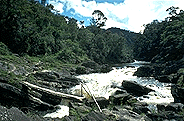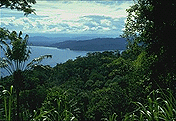

The main vegetation type found in eastern Madagascar is forest -- and in particular, dense evergreen forest (forêt ombrophile sempervirente) with a canopy exceeding 30 m, which occurs at low elevations, as for example in the Baie d'Antongil.
This same type of forest, with a closed canopy that usually reaches up to 20-25 m in height, extends up to middle elevations as well, such as about 1000 m in the Ranomafana National Park.
At even higher elevations a transition occurs to thicket (fourré) that is shorter in stature, like that occurring around 1800 m on the Marojejy massif in northeastern Madagascar.
At the highest elevations a characteristic shrubland (formation arbustive) occurs, rich in Ericaceae and Asteraceae, which is found in places that are more exposed to severe climatic conditions, like those found at ca. 1900 m on the Andringitra massif,
or on the summit area of Marojejy (2,133 m).
In much of the western part of the country, the principal natural vegetation type is a deciduous forest (forêt décidue). Examples include the vegetation on Madagascar's limestone karsts (tsingy), such as those found at the Ankarana Special Reserve in the far north of the island,
or forests on white sand (e.g., near Port Bergé in the northwest).
In the extreme southwest and across the southern part of Madagascar, where conditions are even drier, a specialized thicket vegetation (fourré) is dominated by members of the endemic family Didiereaceae (e.g., in the dry parcel of the Andohahela Reserve),
and by shrubby and arborescent species of Euphorbia, such as E. stenoclada (e.g., at Anakao south of Tuléar).
Species of baobabs, Adansonia, are also widespread throughout the south and west, including majestic stands of A. grandidieri north of Morondava.
Other bottle-trees include Moringa drouhardii near Ianantsony south of Tuléar.